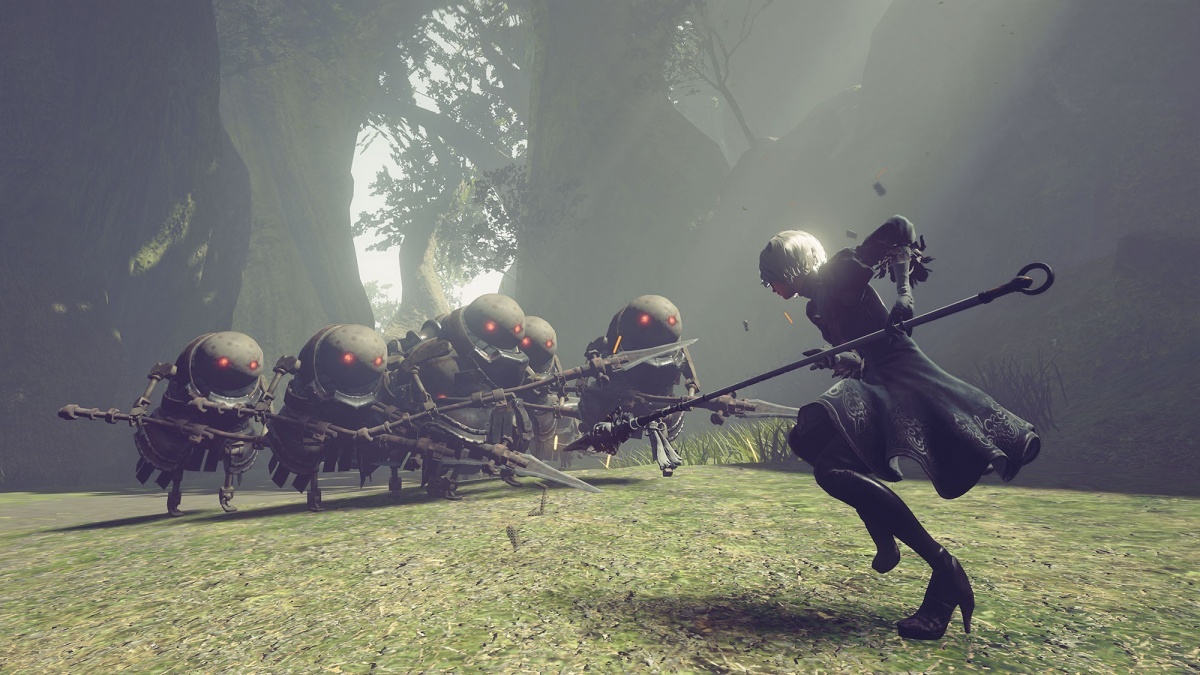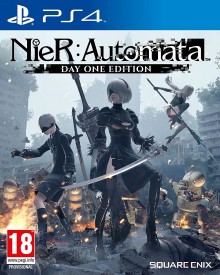Nier: Automata (PlayStation 4) Review
By Coller Entragian  22.03.2017
22.03.2017

Game director Yoko Taro may not be as recognisable as the likes as Suda 51, Shinji Mikami or even as Swery... but that is because his vision always exceeded his grasp. Responsible for the Drakengard series and the cult classic Nier, Taro's games never got mainstream success due to various reasons - most of which have to do with his games' limited budgets or time constraints, which lead to sloppy game design. Calling the gameplay in his past games "sloppy" is actually putting it lightly, since they were oftentimes completely broken in Nier's case, or a sputtering headache-inducing nightmare for Drakengard 3. What made Yoko Taro's games so engaging was his enigmatic writing style and "throw-it-in" cavalier attitude towards genre mixing in his action-RPGs, which gives him an aura of both genius and buffoon. When Dragon Quest producer Yosuke Saito decided he wanted to work with Yoko Taro on a Nier sequel, Platinum Games jumped at the chance to offer their unparalleled ability to deliver polished action game mechanics to Taro's next vision. Nier: Automata is seemingly Taro's last chance to prove he is a good game designer. With Platinum Games at his side, does his epic genre-bending action-RPG sink or swim?
On the surface, it can be easy to assume that Nier: Automata is more of a Platinum Games product than a Yoko Taro game. Do not be mistaken - this game is definitely pure Yoko Taro at his most Taro-iest, but with the deft polish that one could expect from a game developed by Platinum Games. Right from the start, the game makes all kinds of warnings that there is no auto-saving and the first save point is not available until after the first boss. The start is also where most people who select the harder difficulty will experience their first "ending," since dying during the prologue will trigger a quasi-joke ending. Nier: Automata is not afraid of making a weird first impression. It also sets a precedent for the rest of the game: expect the unexpected, and Nier: Automata will definitely defy all expectations to the most jaded gamers out there.

At first, the plot may not seem anything too special: alien robots versus robots made by humans. It is not too long before things take a weird turn and players will realise they have something truly extraordinary on their hands. Like many of Yoko Taro's previous games, Nier: Automata has a very bleak tone and is set in a dark and melancholic post apocalypse. The ruined man-made structures and scorched wastelands compounded with the unbelievable musical score by Keiichi Okabe and Keigo Hoashi truly do drive home a strong sense of loss of life that most other games with similar settings fail to harness. Anyone who has played the original Nier will truly appreciate Automata's atmosphere and themes, since they are so faithfully represented here. While the original game's drama was pretty evenly distributed throughout the adventure, Nier: Automata backloads the heavier plot points, making for one long depressing and emotionally exhausting wallop.
As 2B, many open-ended sand-boxy locations will be explored. From condemned carnivals to a staggeringly vast open desert, Nier: Automata manages to have a strong variety of locales to both explore and do battle in. The developers do get quite a bit of mileage out of the environments as the story goes on, as some of them undergo some radical changes or will feature isolated areas that have fixed camera angles to emphasise twin-stick shooter action with hordes of droids assaulting the playable character. Hidden throughout the land are various components for weapon upgrading, and even some surprisingly involving side quests. Make no mistake that this is the biggest and most epic game Platinum Games has ever made.

It would be easy to assume that Nier: Automata plays something like Bayonetta or Metal Gear Rising: Revengeance since it is made by Platinum Games, but it doesn't, really. This pretty much plays like Nier if it was good. Expect the bullet hell action-RPG fusion from the previous game, but good. Also expect more traditional shoot 'em up sequences, which are some of the best examples of their respective genre since Radiant Silvergun. The chip augmentations offer some real depth for building the player-characters and add a lot more flair to the combat for some creative novelty builds.
While it was stated that is more Nier than Platinum Games, that is not to say there are no signature Platinum Games flourishes here. Enemy tells are very clearly depicted and always have a distinctive audio cue, so perfectly timing a parry or counter attack has a very meaty feedback. To the trained eye, some fans may notice some moves from past games having snuck their way into Yoko Taro's magnum opus, like the input method for rising slashes and, of course, the dodge/parry offset.

Nier: Automata is not 100% perfect, since to other trained eyes, it can be apparent that Platinum Games and Yoko Taro did not have the biggest budget. The weakest aspect is its lack of detail in environments. Expect a lot of hard lines, low fidelity and recycled assets in many of the open-ended locations. The overall presentation is a bit inconsistent, since it ranges from pure inspiration to sometimes looking like an HD remaster of a PlayStation 2 game. Even when not exploring and the game has shifted into a side-scrolling bullet hell shooter, many of the background scenery can look really cheap. This is Nier: Automata at its absolute worst, however, and outside of these examples it would be difficult to reach any further to find any other legitimate faults with the overall presentation.
As par for the course of a Yoko Taro game, Nier: Automata has multiple endings, and it does not disappoint, with a whopping 26 of them. While there are several joke endings and game over endings, there are still some really substantial endings and routes that drastically change the game. In many ways, callings these "endings" is in some way a misnomer, and are better described as intermissions or chapter segues. The only thing it can truly be compared to is other Yoko Taro games. In some routes there may be a much greater focus on scrolling shoot 'em up levels, and others will feature totally different playable characters with their own unique gameplay dynamics. It is pretty staggering to see all this in a game in this day and age of microtransactions and season passes, since if this was made by anyone other than Yoko Taro, all this content likely would have been DLC.

Cubed3 Rating
Exceptional - Gold Award

In spite of all the odds against Yoko Taro's career, he has finally created a true masterpiece that delivers on all fronts that includes gameplay. Environmental detail aesthetics lacking aside, Nier: Automata is an unbelievable game and one that just might make even the most stone cold-hearted gamers well up into a weepy emotional mess. This is a landmark in storytelling in games that is one that embraces the fact it is a video game and does not try to imitate film in the way most story driven games do. Nier: Automata is bold and weird without being pretentious, but most importantly it knows how to be a fun video game thanks to masterclass action game design.

![]() 9/10
9/10
![]() 0
(0 Votes)
0
(0 Votes)
 Out now
Out now  Out now
Out now  Out now
Out now  Out now
Out now Comments
Comments are currently disabled

 Sign In
Sign In Game Details
Game Details Subscribe to this topic
Subscribe to this topic Features
Features






 Top
Top

